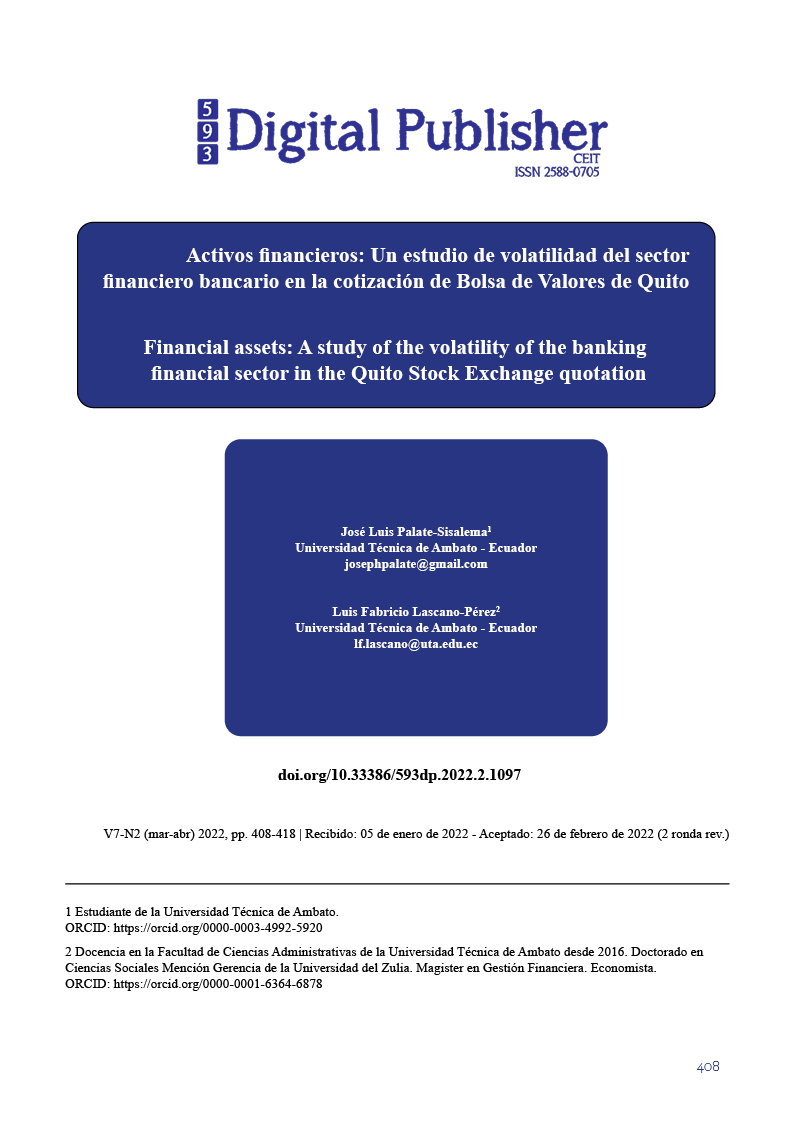Financial assets: A study of the volatility of the banking financial sector in the Quito Stock Exchange quotation
Main Article Content
Abstract
This study analyzed the variability of financial assets belonging to the banking sector in the Quito Stock Exchange. Financial assets are financial instruments or securities that can be a wealth for the owner or an expense for the issuer. The CAPM asset valuation model was used for systematic risk analysis (beta coefficient) by determining the degree of volatility owning stock prices according to the quantitative order correlational method. The methodological design of the work was established under a cross-sectional correlational method, since the behavior of the stock price is analyzed against an expected return due to volatility, measured by the beta coefficient through the valuation model of CAPM assets for determining the volatility of financial assets. The sampling was for convenience, because the banking entities had to maintain daily share prices for a period of one year and be expressed in US dollars. The results obtained were from Banco de Guayaquil, PRODUBANCO and Banco Pichincha and indicated that the prices of the shares that have the highest risk belong to Banco Pichincha, therefore, their performance tends to be mostly volatile and consequently negative. In conclusion, the banking financial sector in 2020 presented high volatility in the price of Banco Pichincha shares followed by Banco de Guayaquil and as a viable option to invest was the PRODUBANCO bank, which generated positive returns.
Downloads
Article Details

This work is licensed under a Creative Commons Attribution-NonCommercial-ShareAlike 4.0 International License.
1. Derechos de autor
Las obras que se publican en 593 Digital Publisher CEIT están sujetas a los siguientes términos:
1.1. 593 Digital Publisher CEIT, conserva los derechos patrimoniales (copyright) de las obras publicadas, favorece y permite la reutilización de las mismas bajo la licencia Licencia Creative Commons 4.0 de Reconocimiento-NoComercial-CompartirIgual 4.0, por lo cual se pueden copiar, usar, difundir, transmitir y exponer públicamente, siempre que:
1.1.a. Se cite la autoría y fuente original de su publicación (revista, editorial, URL).
1.1.b. No se usen para fines comerciales u onerosos.
1.1.c. Se mencione la existencia y especificaciones de esta licencia de uso.
References
Brenes González, H. (2019). El coeficiente beta (β) como medida del riesgo sistemático: Una demostración de que el valor del riesgo sistemático del mercado es igual a uno. REICE: Revista Electrónica de Investigación en Ciencias Económicas, 1-20. https://doi.org/10.5377/reice.v6i12.7473
Lovato, J. (2013). Propuesta de reformas al mercado de valores ecuatoriano. Iuris Dictio, 221-225. https://doi.org/10.18272/iu.v13i15.724
Calvo, A., Parejo, J., Rodriguez, L., & Cuervo, Á. (2014). Manual del Sistema Financiero (25ª.) Español. Barcelona: Editorial Planeta, S. A.
Jimenez, M. (2016) Análisis de volatilidad en productos financieros [Tesis, Universidad Carlos III de Madrid]. http://hdl.handle.net/10016/28430
Rossi, G. (2013). La volatilidad en mercados financieros y de commodities. Un repaso de sus causas y la evidencia reciente. Invenio, 59-74. https://www.redalyc.org/pdf/877/87726343005.pdf
Rodríguez, M. (2017). Análisis de factibilidad de la fusión de las Bolsas de Valores de Quito y Guayaquil, en el Ecuador [Tesis de Maestría, Escuela Politécnica Nacional]. http://bibdigital.epn.edu.ec/handle/15000/17502
Guanotasig, C. (2019). Valoración financiera y las decisiones de inversión, en el sector bancario que cotiza en las bolsas de valores en el Ecuador [Tesis de Maestría, Universidad Técnica de Ambato]. https://repositorio.uta.edu.ec/jspui/handle/123456789/30169
Van Horne, J. C., & Wachowicz, J. M. (2002). Fundamentos de administracion financiera (Vol. XI). Mexico: Pearson Educación.
Hernandez, R., Fernández, C., & Baptista, M. (2004). Metodología de la Investigación. Mexico: McGraw-Hill Interamericana.
Florez, L. (2008). Evolución de la Teoría Financiera en el Siglo XX. Ecos de Economía, 12(27), 145-168. https://www.redalyc.org/pdf/3290/329027263004.pdf
Coronel, J., & Ramos, E. (2016) Determinación de un Portafolio Óptimo de Inversiones en Negocios Inclusivos del Ecuador mediante la aplicación de Teoría de Portafolios de Harry Markowitz [Tesis, Universidad Catolica Santiago de Guayaquil]. http://repositorio.ucsg.edu.ec/bitstream/3317/6808/1/T-UCSG-PRE-ECO-ADM-329.pdf
Red de Instituciones Financieras de Desarrollo y Equifax. (Febrero de 2020). Covid-19 y sus implicaciones en el Sistema Financiero Nacional. https://repositorio.uta.edu.ec/jspui/handle/123456789/29426
Roque, I., Muñoz, A., Escobar, J., & De Con, F. (2021). El uso de la beta contable como método de evaluación de riesgos para empresas no cotizadas en Colombia. Universidad y Sociedad, 13(2). http://scielo.sld.cu/scielo.php?script=sci_abstract&pid=S2218-36202021000200023
Acosta, G., & Avilés, B. (2018). Influencia de la globalización financiera en el mercado de valores ecuatoriano. Revista Ciencia UNEMI, 52-65. http://dx.doi.org/10.29076/issn.2528-7737vol11iss27.2018pp52-65p
Vivanco, J. (2019). El índice BETA como base de predicción de riesgos en carteras de inversión. Trascender, Contabilidad y Gestión, 42-51. http://www.repositorioinstitucional.uson.mx/handle/unison/5676
Nivin, R. (2019). Medidas alternativas de volatilidad en el mercado de valores peruano. Revista de Análisis Económico y Financiero, 7-14. https://www.aulavirtualusmp.pe/ojs/index.php/raef/article/view/1693
López, M. (2016) Estrategias sustentables para aumentar la participación de las Cooperativas de Ahorro y Crédito en la Bolsa de Valores de Quito [Tesis, Universidad Central del Ecuador]. http://www.dspace.uce.edu.ec/handle/25000/8723
Diez, S. (2016). Metodología de cálculo del costo promedio ponderado de capital en el modelo del WACC. Revista Empresarial Latindex, 33-45. https://editorial.ucsg.edu.ec/ojs-empresarial/index.php/empresarial-ucsg/article/viewFile/50/44
Grande, D. (2018) El CAPM y su aplicación a países emergentes [Tesis de Maestría, Universidad Nacional de Rosario]. http://rephip.unr.edu.ar/bitstream/handle/2133/11518/Tesis%20Dante%20Grande%20VFINAL%2027-04-2018.pdf?sequence=2
Comun, L., & Huaman, P. (2019) Adaptación del modelo CAPM en mercados emergentes [Tesis, Universidad Peruana de Ciencias Aplicadas]. http://hdl.handle.net/10757/626342
Laurente, M., & Saldaña, L. (2019) Controversia del CAPM con relación al riesgo y rentabilidad de activos financieros frente a otros modelos alternativos y derivados [Tesis, Universidad Peruana de Ciencias Aplicadas]. http://hdl.handle.net/10757/628015
Auz, R. (2015) Análisis de eficiencia de la Bolsa de Valores de Quito, periodo 2013-2015 [Tesis, Escuela Agrícola Panamericana, Zamorano]. https://bdigital.zamorano.edu/bitstream/11036/4460/1/AGN-2015-003.pdf



